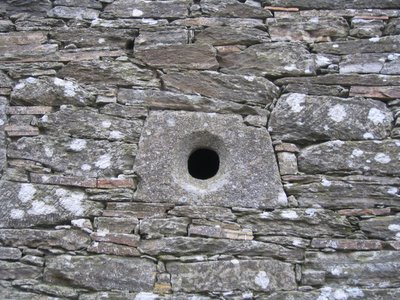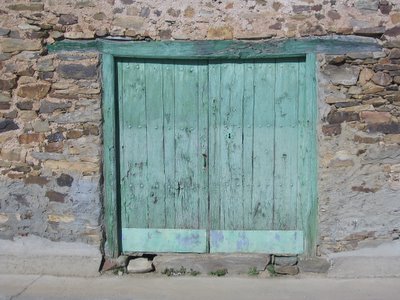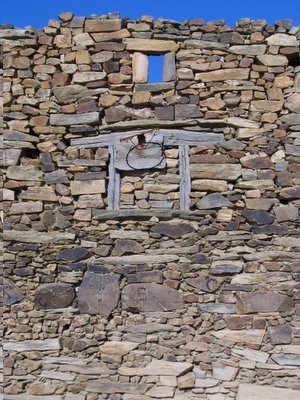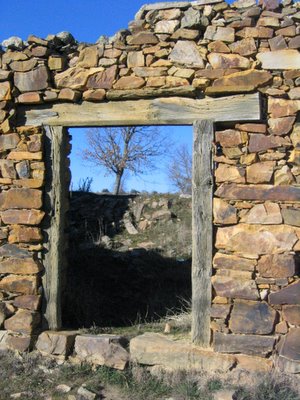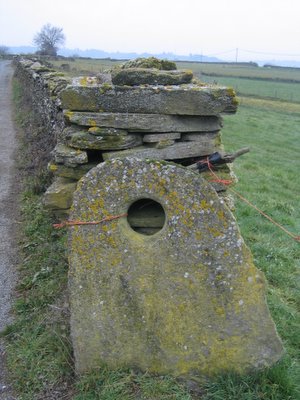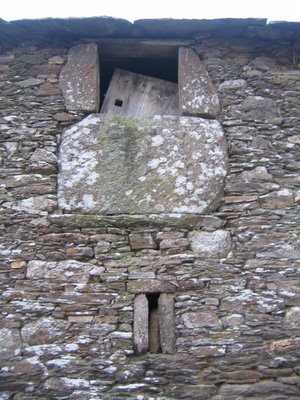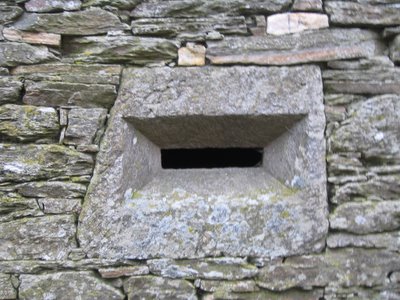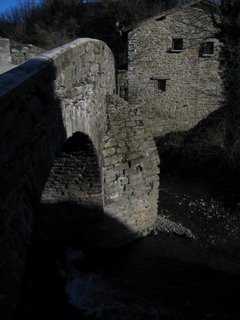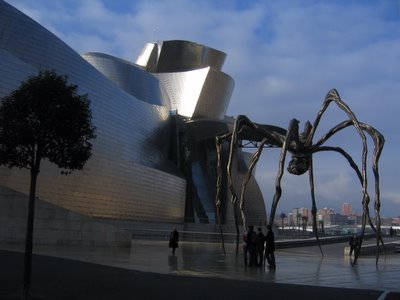Sunday, February 05, 2006
Thursday, February 02, 2006
Fog out of Burgos
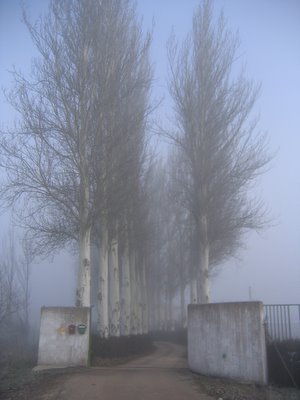
Out of Burgos, I hit several days of fog, it was beautiful and surreal.
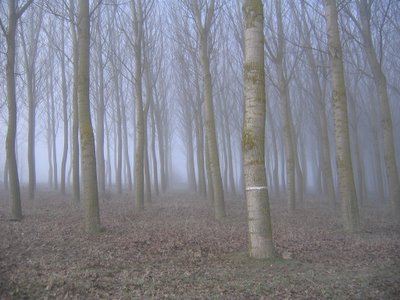

The dew freezes on the trees and grass - when the light hits it is very beautiful.
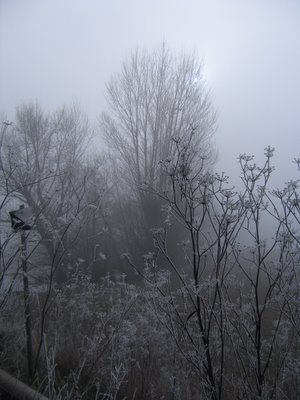
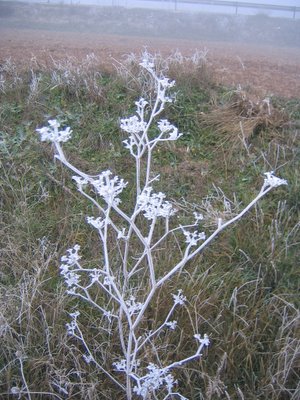
As you walk along, things gradually appear, giving even more mystery to the landscape.
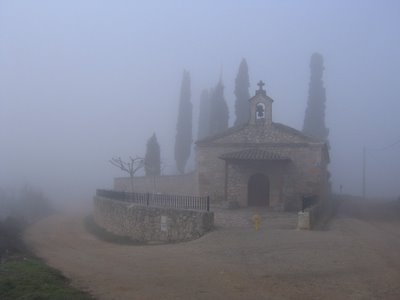
Sunday, January 29, 2006
Logrono and beyond

In the morning I hear guns going off all around me - hunting season.
Lunch after the climb out of Villafranca Montes de Oca. Queso, Jamon Serrano, Pimiento, Pan!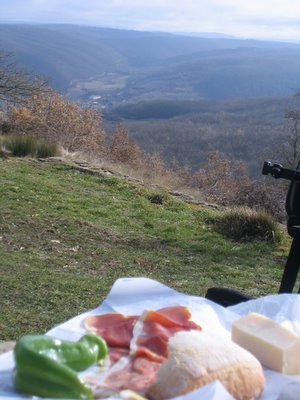
Starting to show the road wear!
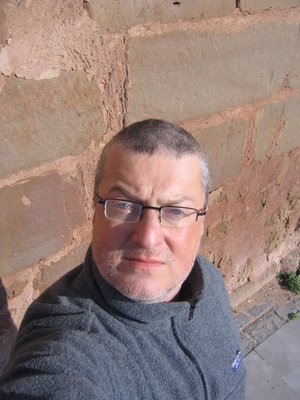
All the land is intensly cultivated, each region has its own method for irrigation
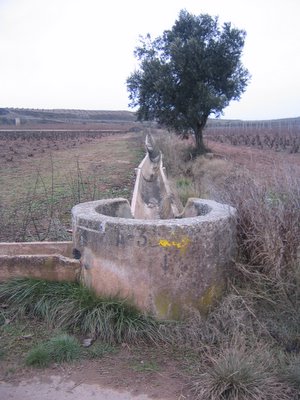 There are vineyards for miles around me as I walk, like forests of Spanish bonsai trees.
There are vineyards for miles around me as I walk, like forests of Spanish bonsai trees.
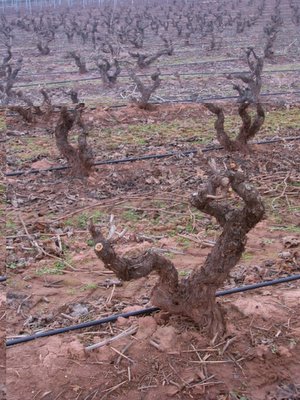
The trees have a mustard-orange lichen on them.
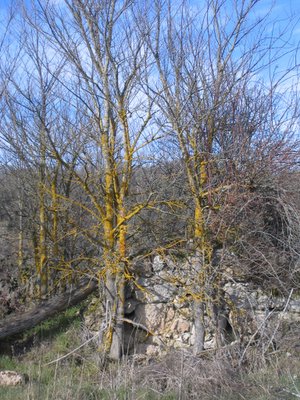
View of Hornillos.

Landscape by Beckett!
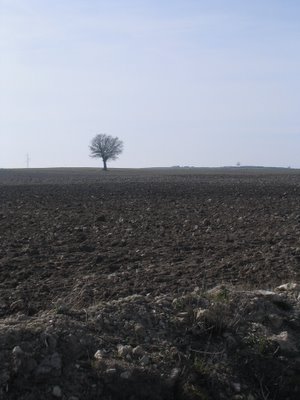
Back to the Camino.

Sunday, January 22, 2006
Roncesvalles - first day on the Camino

A very early (and expensive!) cab ride from Pamplona to Ronsecvalles, the starting point in Spain for the Camino de Santiago Compostela. In the dark we drive up into the Pyrenes, arriving at the refugio, convent and chapels of Roncesvalles.
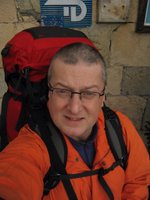 The Camino de Santiago Compostela is a medeival Pilgramage route that crisscrosses throughout Europe and Spain ending at the Cathedral of Santiago honoring St. James, the apostle and pilgrim. The Camino Frances - the most common route that connects all the routes in Europe and travels through Spain is 750 km long. Finding myself between jobs with a desire for a challenging trip, I thought this may be a perfect time for such an ambitious undertaking. It is also an opportunity to visit a lot of new archtiecture in Spain. The combination of physical challenge, cultural history and comtemporary architecure became key in my decision to follow the Way of Saint James.
The Camino de Santiago Compostela is a medeival Pilgramage route that crisscrosses throughout Europe and Spain ending at the Cathedral of Santiago honoring St. James, the apostle and pilgrim. The Camino Frances - the most common route that connects all the routes in Europe and travels through Spain is 750 km long. Finding myself between jobs with a desire for a challenging trip, I thought this may be a perfect time for such an ambitious undertaking. It is also an opportunity to visit a lot of new archtiecture in Spain. The combination of physical challenge, cultural history and comtemporary architecure became key in my decision to follow the Way of Saint James.Roncesvalles is where a great battle was fought, the story of the famous French medeival epic, The Song of Roland. Charlemagne, while fighting the Saracens in Spain, was called back over the Pyrenees, leaving the great hero Roland and a small band here to cover his retreat.
 Roland is given a great horn to blow if he needs help, a horn only he can blow, a horn that can be heard hundreds of miles away and will make the ground shake. 400,000 Saracens attack Roland in here and the Franks left behind to fight fall one by one. Roland refuses to blow the horn until the last moment, but it is too late, by the time Charlemagne returns to help him he has been killed.
Roland is given a great horn to blow if he needs help, a horn only he can blow, a horn that can be heard hundreds of miles away and will make the ground shake. 400,000 Saracens attack Roland in here and the Franks left behind to fight fall one by one. Roland refuses to blow the horn until the last moment, but it is too late, by the time Charlemagne returns to help him he has been killed.I look around at the mountainous country, what must have the fighting been like in these hills and valleys? I am glad I am starting here and not on the French side of the Pyrenees, I can ride up into the foothills and walk down.
 It is still dark, everything is locked up tight. I wander about in the cold with my heavy pack. A man and a young woman show up, wandering around like myself. They are Spanish, a father is being dropped off for the trail by his daughter. He will hike for a week, his has been putting together several trips to do the entire Camino. This summer he will finish the last leg on July 25 the traditional day of festivities. No one is around and he decides to move on, leaving me with the traditional greeting - ´Buen Camino´. He suggests I go wait in the church where it is warm.
It is still dark, everything is locked up tight. I wander about in the cold with my heavy pack. A man and a young woman show up, wandering around like myself. They are Spanish, a father is being dropped off for the trail by his daughter. He will hike for a week, his has been putting together several trips to do the entire Camino. This summer he will finish the last leg on July 25 the traditional day of festivities. No one is around and he decides to move on, leaving me with the traditional greeting - ´Buen Camino´. He suggests I go wait in the church where it is warm.Sitting in the church, a small dark chapel (but warm!) - suddenly it is filed with chanting. Two couples entire the chapel, greeting each other quietly. A Priest enters and performs a service. A good start for my trip.
 After I go outside and shortly a woman drives up and parks. I follow her and ask if she can provide me a credentiale, a certificate I will need as a travel, this will be stamped as I make my way proving I hvae hiked the entire route. Having accomplished this I take care of another important piece of business, breakfast. A small cafe nearby is filled with a bus load of Camino hikers, elderly, but all vigorous, jovial and excited. It is 8:30AM and I see several brandy snifters among these experirenced peregrinos. I think to myself, I could get used to this! Ah, I have accomplished so much today, a long ride, service, the search for my credentiale, now a respite in this cozy cafe, let me see, so far I have hiked exactly how many miles of the Camino?
After I go outside and shortly a woman drives up and parks. I follow her and ask if she can provide me a credentiale, a certificate I will need as a travel, this will be stamped as I make my way proving I hvae hiked the entire route. Having accomplished this I take care of another important piece of business, breakfast. A small cafe nearby is filled with a bus load of Camino hikers, elderly, but all vigorous, jovial and excited. It is 8:30AM and I see several brandy snifters among these experirenced peregrinos. I think to myself, I could get used to this! Ah, I have accomplished so much today, a long ride, service, the search for my credentiale, now a respite in this cozy cafe, let me see, so far I have hiked exactly how many miles of the Camino? 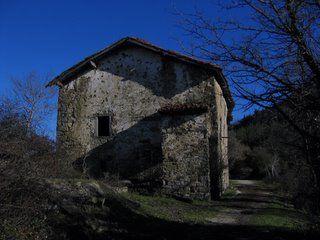 Time to get going - the camino here is beautiful and wooded, the morning is misty and perfectly cool. Dispite the large group in the cafe, I don´t meet any fellow pilgrams as I walk.
Time to get going - the camino here is beautiful and wooded, the morning is misty and perfectly cool. Dispite the large group in the cafe, I don´t meet any fellow pilgrams as I walk. Thursday, January 19, 2006
Bilbao 3 - Serra and Gehry
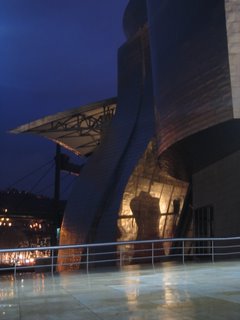 The Guggenheim is impressive, a vast multi-limbed ´carp´or otherworldly creature reaching around and through the bridge and city around it. Windows appear as gills, illuminating the massing in interesting ways. Inside it is its own exhibit, the central hall a twisted sculptural space.
The Guggenheim is impressive, a vast multi-limbed ´carp´or otherworldly creature reaching around and through the bridge and city around it. Windows appear as gills, illuminating the massing in interesting ways. Inside it is its own exhibit, the central hall a twisted sculptural space.Serra, a whole room of them. Repetitive, but excellent. The surfaces of the steel show tremendous variation. Some are scratched, but not in a mechanical way, some seem to have a vestigial paint layer, eaten away by some corrosive process. All the surfaces are quite beautiful. they remind me of the huge Monet paintings of the water surface, you can swim in them.
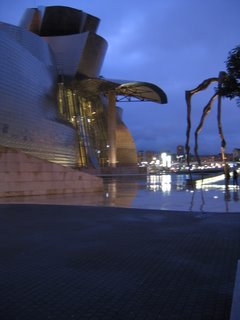 The spirals and spaces of the pieces, the closing and opening and light variations, are fascinating. I walked through every curve and squiggle. Coming to an open oval, one side seeming to tip back to open to the light after the long enclosed passage was calmly stunning. The relation to Gehry´s work is clear, yet the surface, weight and thinness of the Serra´s work seems more satisfying. (see link)
The spirals and spaces of the pieces, the closing and opening and light variations, are fascinating. I walked through every curve and squiggle. Coming to an open oval, one side seeming to tip back to open to the light after the long enclosed passage was calmly stunning. The relation to Gehry´s work is clear, yet the surface, weight and thinness of the Serra´s work seems more satisfying. (see link)Serra and Gehry
I think a key issue for architecture today is the thinness and layering of construction. Gehry´s work is very well handled, he understands surface and handles it consistantly. Still sometimes I look for more, for instance, the marble floor is similar to the tile used as a light skin on the open constrcution of the tower. Monolithic construction is nowhere in this work, but one wonders if the ground plane should have a different feel, weight or materiality than the undulating walls. The success of his work is in his recognition of the contemporary ´skin´construction as dominant. He uses these surfaces and the massing and windows to create and expose the monolithic vs skin relationships.
The complimentary and contradictory notions of skin, volume, weight, monolithic volume and interior space is what makes the Serra-Gehry comparison so interesting and Serra´s work so compelling.

The 2nd aspect of Gehry´s work is his recognition that he has created an architectural language and will use it to develope a archtiectural design with urban implications. The movement of the building, the different approaches one can take, its interactions with the bridge and the river are all part of the interest. I can see Gehry imaging the various passages one can take to and through his building - although I wonder if this aspect of his work could be even stronger. I feel the architectural world is so taken with single images of buildings that the experience of movement around and through a building is often lacking.
 One aspect I had always been fascinated by when I first saw models of the building, was a large window that pops up to the highway that passes over head. (photo of the window from my bus ride from the airport into the city). I had always loved this gesture, but after walking around and asking several guides I finally figured out that this was just a skylight in the Serra Gallery. I was disappointed. I thought having a gallery with a large window onto the highway to bring people close to the inhuman scale of the city´s infrastructure while people driving by would get a glimpse into this unique space. That would have been a great gesture.
One aspect I had always been fascinated by when I first saw models of the building, was a large window that pops up to the highway that passes over head. (photo of the window from my bus ride from the airport into the city). I had always loved this gesture, but after walking around and asking several guides I finally figured out that this was just a skylight in the Serra Gallery. I was disappointed. I thought having a gallery with a large window onto the highway to bring people close to the inhuman scale of the city´s infrastructure while people driving by would get a glimpse into this unique space. That would have been a great gesture.
Bilbao 1 - Calatrava
I fly into Bilbao and as the plane taxis into the landing gate I look out the window and realize the airport is by the Spanish Architect, Santiago Calatrava. Since I intend to combine my hiking of the Camino with a tour of new architecture in Spain this seems like a good omen.
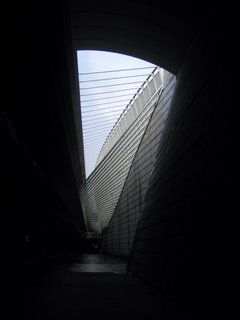 I had admired Calatrava´s work when he was a ´bone man´ and a structural engineer. It seems that , with the help of a PR firm, he is trying to recast himself as a ´artist´. I saw images of his work in Tenerife and felt it was very bad - bad pseudo artist architecture. Martin Fuller gave an excellent summary of Calatrava´s work in the New York Review of Books, putting into words things I had be seeing in his architecture for awhile. I had appreciated Calatrava´s earlier work, his examination of animal skeletal structure and structural engineering had seemed a good source for invention. The airport was an early work and is quite nice. The concrete work hasn´t always aged well (I have real reservations about concrete as a material - more on that later), but the building breaks into a simple diagram of the functions, the linear airport landing gate with its articulated walkways in some ways seem a perfect canvas for Calatrava´s approach. Particularly good was the integration the builidngs into the landscape, the parking garage in particular. In fact some of the more compelling things I saw were in the parking garage - which in a way seems appropriate for this architect, maybe when he tries a little less hard the results are better.
I had admired Calatrava´s work when he was a ´bone man´ and a structural engineer. It seems that , with the help of a PR firm, he is trying to recast himself as a ´artist´. I saw images of his work in Tenerife and felt it was very bad - bad pseudo artist architecture. Martin Fuller gave an excellent summary of Calatrava´s work in the New York Review of Books, putting into words things I had be seeing in his architecture for awhile. I had appreciated Calatrava´s earlier work, his examination of animal skeletal structure and structural engineering had seemed a good source for invention. The airport was an early work and is quite nice. The concrete work hasn´t always aged well (I have real reservations about concrete as a material - more on that later), but the building breaks into a simple diagram of the functions, the linear airport landing gate with its articulated walkways in some ways seem a perfect canvas for Calatrava´s approach. Particularly good was the integration the builidngs into the landscape, the parking garage in particular. In fact some of the more compelling things I saw were in the parking garage - which in a way seems appropriate for this architect, maybe when he tries a little less hard the results are better. In the city of Bilbao was one of his bridges, again an early work and its emphasis on structure as a form giver is very good. Architecturally it is really excellent, the way the bridge curves across the river with the elipsoidal ´structural´ arch counterbalancing the pedestrain way and the cable stays creating a inviting space for passage are all very good. It seems less structurally ´honest´than I at first thought. The detailling
In the city of Bilbao was one of his bridges, again an early work and its emphasis on structure as a form giver is very good. Architecturally it is really excellent, the way the bridge curves across the river with the elipsoidal ´structural´ arch counterbalancing the pedestrain way and the cable stays creating a inviting space for passage are all very good. It seems less structurally ´honest´than I at first thought. The detailling 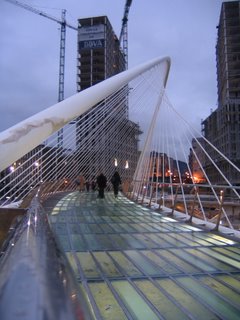 shows a large steel rod elegantly balanced on one point on a concrete pier at each end of the bridge. A closer look at the detail reveals a large piece of steel connected to the rod to prevent rotation. While a quick view of the bridge would seem to indicate it is delcately balanced on these two points - I´m not sure that is true, it seems very off balance and these concrete counter arms are very necessary to preventing the bridge from tipping, which made me wonder if the curved arch above was really doing any work at all, the cable stays seems quite loose and the other strcuture in the bridge seems sufficient for the loads of pedestrian loads. In a way, I feel the architectural expression is so successful, I don´t mind the structural inconsistacies. Still it made me wonder about the kind of short cuts that Calatrava will take in his work.
shows a large steel rod elegantly balanced on one point on a concrete pier at each end of the bridge. A closer look at the detail reveals a large piece of steel connected to the rod to prevent rotation. While a quick view of the bridge would seem to indicate it is delcately balanced on these two points - I´m not sure that is true, it seems very off balance and these concrete counter arms are very necessary to preventing the bridge from tipping, which made me wonder if the curved arch above was really doing any work at all, the cable stays seems quite loose and the other strcuture in the bridge seems sufficient for the loads of pedestrian loads. In a way, I feel the architectural expression is so successful, I don´t mind the structural inconsistacies. Still it made me wonder about the kind of short cuts that Calatrava will take in his work.
